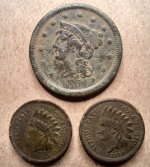konnon6
Full Member
- Feb 13, 2007
- 116
- 0
- Detector(s) used
- homemade/whites DFX/MinlabGP3000/Garret 250
I've asked for years, were there really any pirates?If so where's the proof?I herd the town of Montery was threatened. But were they pirates?Were they spanish bandits? Say from mexico? Does anybody
have anything? leads of somekind?
have anything? leads of somekind?



 Thanks for your input.
Thanks for your input.


